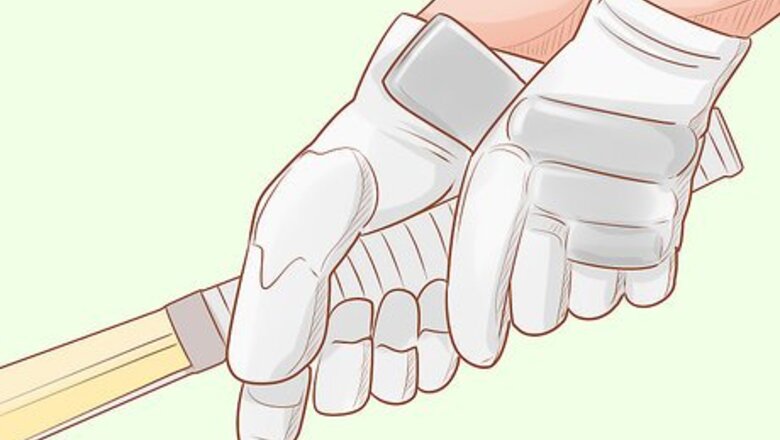
views
Getting into Position

Take a firm grip on the bat with both hands. Wrap both hands around the handle of the bat with your dominant hand closest to the blade. For maximum control and precision, place your hands somewhere between the middle and top of the handle and keep them close enough together for the space between the thumb of your upper hand and the forefinger of your lower hand to form a 'V' shape. The further away you place your hands on the handle, the more awkward maneuvering the bat will become.
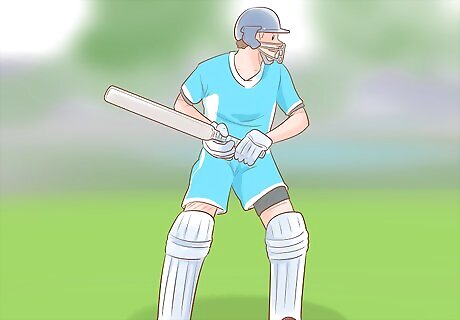
Assume a comfortable stance. Most batsmen prefer a side-on stance. If you’re right-handed, turn your left side toward the bowler with the bat off to your right side. If you’re left-handed, simply reverse this position. Plant your feet about shoulder width and put a little bend in your knees. Keep your weight distributed evenly on the balls of your feet. Once you’re in a basic side-on stance, angle your feet or upper body to get into a position that feels more natural. There’s no single best batting stance for cricket. The important thing is that you choose a stance that offers maximum stability and leverage so you can hit with more force. Be prepared to tweak your stance during games to adapt to different shots. If the bowler delivers a bouncer just in front of your feet, for instance, you'll need to be ready to shift your weight and play a cut off your back foot.

Chamber the bat at waist height until it’s time to swing. Hold the bat out to the side so that it's parallel with the ground, or keep it pointed up or down at a slight angle. The exact position of the bat doesn't matter as long as you're able to move it quickly and easily to initiate your swing. Make sure you’re holding the bat with the flat side facing the bowler. Since most bowls tend to be delivered closer to ground level, a cricket bat shouldn't be held as high as a baseball bat.
Delivering a Proper Swing
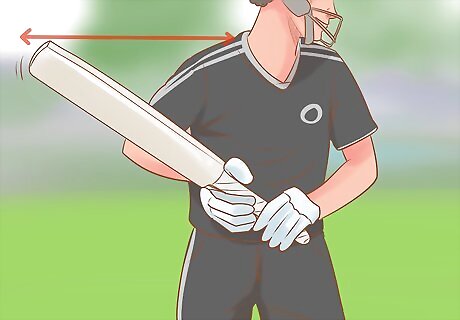
Begin lifting the bat as the bowler delivers the ball. Bring the bat up and back until it’s hovering just below shoulder height. From here, you’ll be able to move forward or backward while making sure the bat stays in the ready position. Keep your elbows bent and your shoulders relaxed but ready to strike. If you wait until the bowler releases the ball to start pulling back, you won’t be able to reverse the motion of the bat in time to make contact at the optimal distance. Avoid raising the bat at too much of an angle, as this can throw off the accuracy of your swing.

Swing the bat straight up to meet the ball. Quickly bring the bat back across your body with the blade perpendicular to the ground or at a horizontal angle. Make an effort to strike the ball as close to the center of the bat as possible. This is the basic technique used for most basic shots, including drives and defensive hits. Watch the ball closely as it crosses the pitch to determine which type of shot you'll need to play. The batting action in cricket has more in common with a tight, controlled golf swing than the wide, horizontal arc of a baseball bat.
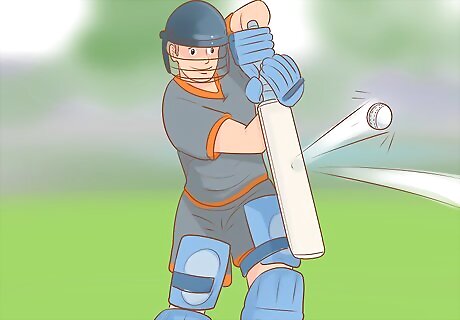
Follow through to get more distance on your shot. As you make contact, twist your hips and open up your chest in the direction of your swing. Continue driving the bat upwards without taking your non-dominant hand off the handle. A smooth, well-timed rotation will generate more momentum, sending the ball further. An exaggerated follow through is most useful for hitting drives, and may not be necessary when you're just trying to prevent the ball from making it to the wicket.
Hitting with More Success
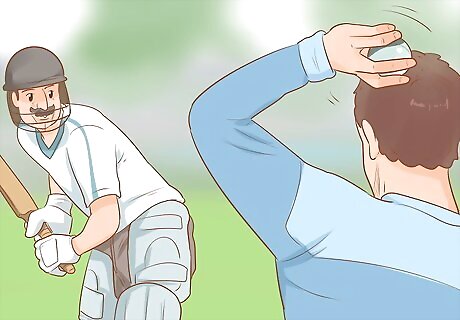
Study the bowler for tells. Pay close attention to the bowler and study the way their run up, foot placement, and release change when they’re delivering different types of shots. Picking up on subtle cues can sometimes tip you off to the type of shot they have in mind. For example, a bowler may modify their grip when they’re planning on delivering a Yorker, or lean slightly when bowling wide on the leg side. A elite-level batsman puts just as much thought into the bowler’s game as his own.
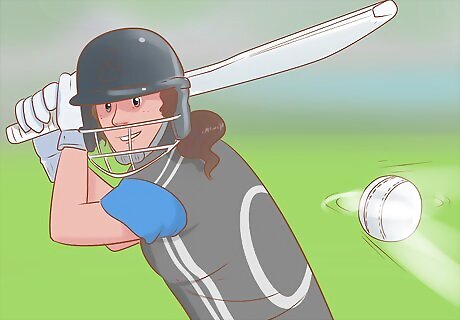
Keep your eye on the ball as it comes down the pitch. Once the ball has left the bowler’s hand, do your best to anticipate where it will end up as it nears the batting crease. By following the movement of the ball closely, you’ll able to predict its path and react appropriately. Most bowls tend to move very quickly, so try not to take your eyes off the ball for even a second.

Move forward or backward as needed to stay behind the ball. As the ball comes closer, be ready to adjust your footwork so you can put yourself in just the right position to get a good swing. This will often require you to make the split-second decision whether to play forward or back. As a general rule, it’s a good idea to keep to the range you’re most comfortable with as much as possible. Staying behind the ball also cuts down on your chances of stopping it with your body rather than your bat (a leg-before-wicket foul).

Wait for the perfect moment to swing. The main objective of batting is to rack up runs, not to hit every ball that comes your way. For this reason, knowing how to bide your time is just as important as knowing how to swing. Attempting to answer every delivery will only waste valuable energy and cause you to become frustrated. If hitting a ball requires you to get into an awkward position or alter your stance or technique dramatically, it’s usually best to just let it go.

Double back after a driving hit to score more runs. Once you reach the far crease, turn around and run back to your starting position before a fielder can deliver the ball to the wicket. If you're successful, you'll be awarded a run each time you reach the opposite wicket. This strategy works best when you've managed to hit the ball far enough afield to buy yourself extra time on the pitch. By hurrying back and forth across the pitch repeatedly (a strategy sometimes referred to as "running between wickets"), you stand to score as many as 4 runs off a single ball. Always check to make sure you and your fellow batsman are in the clear before attempting multiple runs. If a fielder gets hold of the ball while you're still in motion, there's a chance they could hit the wicket and score a run-out.
Stepping up Your Game
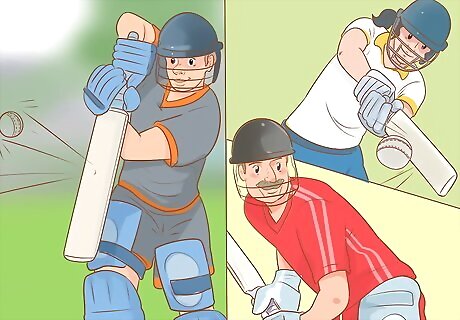
Practice regularly to improve your skills. There’s no substitute for practice. Attend team practices as often as you can, and try to get out and train on your own at least a couple times a week. These sessions will give you a chance to refine your technique, smooth out your weak points, and get some experience hitting different kinds of shots. Make better use of your practice time by choosing 1 or 2 specific skills to work on. You might drill off-drives one session, then focus on hooks or sweeps the next. Swinging a heavy cricket bat repeatedly can place a lot of strain on your shoulders, so be sure to take a day off to rest here and there when you start to feel sore or achy.

Try weight lifting or resistance training to increase your total body strength. Start lifting weights or doing some form of resistance training 3-4 times a week to supplement your batting practice. Focus on movements like the bench press, shoulder presses, rows, and bicep curls that target the main muscle groups used in batting. The stronger you are, the more power you’ll be able to channel into your swing. If you don’t have access to free weights, you can still get an effective workout by performing bodyweight exercises like push ups, pull ups, dips, and crunches. Batting isn’t just done with the upper body. In order to put your full power into a swing, you also need a stable base and a strong core, so be sure to incorporate some lower body and abdominal exercises, such as squats, lunges, sit ups, and planks.

Hone your preferred batting style. If you’re unmatched as a forefoot batter, for example, there’s no sense in making yourself play off your back foot unless it’s absolutely necessary. Similarly, if you have difficulty hitting cuts, stick to shots you can make time after time to increase your chances of success. Regular practice will help bring up the weak parts of your game, but it’s just as crucial to use what you're good at. Continue sharpening your strongest skills until you can execute them consistently under pressure. The most capable batsmen are the usually the ones who know how to take advantage of the skills that come most naturally to them.

Learn to concentrate in short, intense bursts. Batting requires incredible focus. To perform at your peak, you need to be able to shut out the roar of the crowd, the taunts of the opposing team, and the feeling of disappointment that comes from missing a shot. Keep your mind fixated on your technique and tracking the ball as it moves into striking range. Try not to let 1 or 2 bad innings shake your confidence. When you're coming off a disappointing play, take a few slow, deep breaths to calm and recenter yourself. Don't forget to have fun! After all, you wouldn't be playing cricket if you didn't enjoy it.




















Comments
0 comment